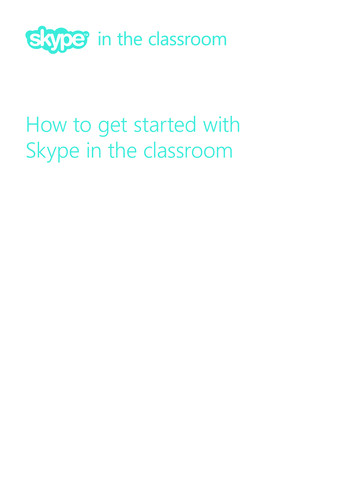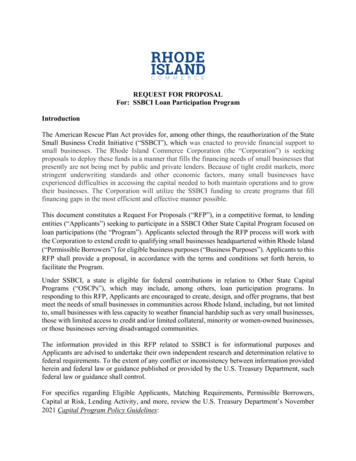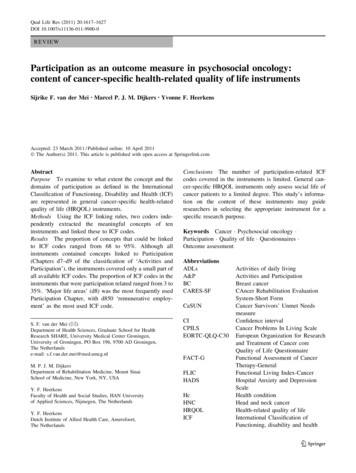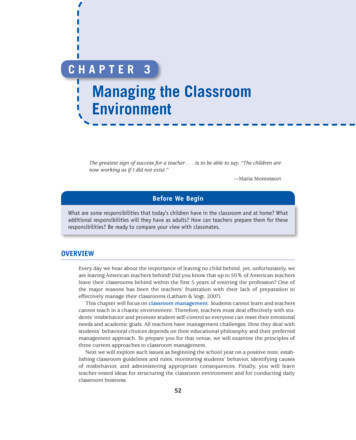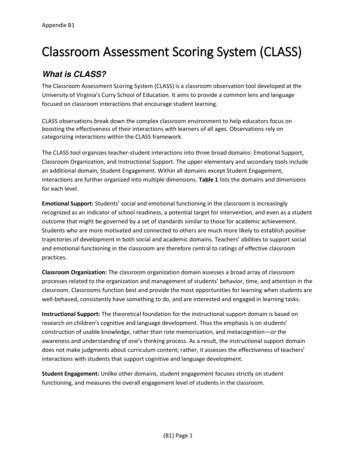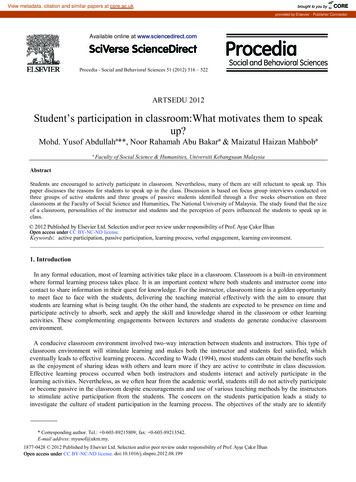
Transcription
View metadata, citation and similar papers at core.ac.ukbrought to you byCOREprovided by Elsevier - Publisher ConnectorAvailable online at www.sciencedirect.comProcedia - Social and Behavioral Sciences 51 (2012) 516 – 522ARTSEDU 2012Student’s participation in classroom:What motivates them to speakup?Mohd. Yusof Abdullahª**, Noor Rahamah Abu Bakarª & Maizatul Haizan Mahbobªª Faculty of Social Science & Humanities, Universiti Kebangsaan MalaysiaAbstractStudents are encouraged to actively participate in classroom. Nevertheless, many of them are still reluctant to speak up. Thispaper discusses the reasons for students to speak up in the class. Discussion is based on focus group interviews conducted onthree groups of active students and three groups of passive students identified through a five weeks observation on threeclassrooms at the Faculty of Social Science and Humanities, The National University of Malaysia. The study found that the sizeof a classroom, personalities of the instructor and students and the perception of peers influenced the students to speak up inclass.2012 erresponsibilityof Prof.ofDr.Prof.AyseAyúeCakirÇakÕrIlhanølhan orreviewresponsibilityOpen access under CC BY-NC-ND license.Keywords: active participation, passive participation, learning process, verbal engagement, learning environment.1. IntroductionIn any formal education, most of learning activities take place in a classroom. Classroom is a built-in environmentwhere formal learning process takes place. It is an important context where both students and instructor come intocontact to share information in their quest for knowledge. For the instructor, classroom time is a golden opportunityto meet face to face with the students, delivering the teaching material effectively with the aim to ensure thatstudents are learning what is being taught. On the other hand, the students are expected to be presence on time andparticipate actively to absorb, seek and apply the skill and knowledge shared in the classroom or other learningactivities. These complementing engagements between lecturers and students do generate conducive classroomenvironment.A conducive classroom environment involved two-way interaction between students and instructors. This type ofclassroom environment will stimulate learning and makes both the instructor and students feel satisfied, whicheventually leads to effective learning process. According to Wade (1994), most students can obtain the benefits suchas the enjoyment of sharing ideas with others and learn more if they are active to contribute in class discussion.Effective learning process occurred when both instructors and students interact and actively participate in thelearning activities. Nevertheless, as we often hear from the academic world, students still do not actively participateor become passive in the classroom despite encouragements and use of various teaching methods by the instructorsto stimulate active participation from the students. The concern on the students participation leads a study toinvestigate the culture of student participation in the learning process. The objectives of the study are to identify* Corresponding author. Tel.: 0-603-89215809; fax: 0-603-89213542.E-mail address: myusof@ukm.my.1877-0428 2012 Published by Elsevier Ltd. Selection and/or peer review under responsibility of Prof. Ayúe ÇakÕr ølhanOpen access under CC BY-NC-ND license. doi:10.1016/j.sbspro.2012.08.199
Mohd. Yusof Abdullah et al. / Procedia - Social and Behavioral Sciences 51 (2012) 516 – 522517forms and level of participation and to examine the factors influenced students to actively participate in classroom.This paper highlights the reasons that motivate students to speak up in classroom. The discussion is based on theinformation gauged from the students during focus group interviews.2. Literature ReviewSimply defined, learning is acquiring new or modifying existing knowledge, skills or behaviours. Therefore, iflearning is defined as quest for knowledge, skills or behaviours, then students need to be active in that quest.Students must be proactive to seek the knowledge by seeking as well as receiving information in an outsideclassroom. How the students seek and receive information are usually reflected in their behaviours in theclassroom. The behaviours of students in classroom may range from passive to active participations. They may justsit quietly, taking notes, listening, doing something else, or asking questions, giving opinions, or answeringquestions posed (Mohd Yusof, et al 2011; Hussein, 2010; Bas, 2010). The first four is a passive type of behaviourswhile the latter is an active type of classroom behaviours.Liu (2001) elaborated four types of student behaviours in the classroom as full integration, participation in thecircumstances, marginal interaction, and silence observation. In full integration, students engage actively in the classdiscussion, know what they want to say and what they should not say. Their participation in class is usuallyspontaneous and occurs naturally (Zainal Abidin 2007). Participation in the circumstances occurs when studentsinfluenced by factors, such as socio-cultural, cognitive, affective, linguistic, or the environment and these often leadto student participation and interaction with other students and instructors become less and speak only at appropriatetime. In marginal interaction, students act more as listeners and less to speak out in the classroom. Unlike thestudents who actively participate in the classroom discussions, this category of students prefer to listen and takenotes than involved in the classroom discussion. Lastly, in silent observation, students tend to avoid oralparticipation in the classroom. They seem to receive materials delivered in the classroom by taking notes usingvarious strategies such as tape-recording or writing.Based on the various types of classroom behaviours, to be an active learners, whenever in the classroom, studentsmust engage actively by playing the roles of information seekers. The acts of asking questions, give opinions orsimply answering questions posed by the instructor or fellow students are examples of active type of classroomparticipation. According to Davis (2009), student’s enthusiasm and willingness to participate in a classroom throughthese verbal engagements will create a conducive classroom environment.Past studies have shown that there are several factors influenced the student’s participation in the process oflearning. The first factor lies in the personality of the students. Students with high self efficacy showed betteracademic achievement and participating more in the classroom (Pajares, 1996 & Schunk, 1995). Self-efficacy traitwith displaying more of that curiosity and exploring urge would motivate students to become more active andpositive reciprocity (Rahil, Habibah, Loh, Muhd Fauzi, Nooreen, Maria Chong, 2006). Thus, if students’ selfefficacy is high, it will enhance their confident level to become more active and speak more in the classroom. Theywill show higher interest to learn more and know more with asking questions, giving opinions and discussing thetopics in the classroom. Students can become passive in classroom discussion due to the self-limitations, such ascannot focus during lecture or learning time, fear of offense (Siti Maziha, Nik Suryani & Melor, 2010), low levels ofself-confidence, do not make preparations before class, fear of failing to show their intelligence, fear that theiranswers will be criticized by the lecturers and the feelings of confusion, thus becoming less engaged in classroomdiscussions (Fassinger, 1995; Gomez, Arai & Lowe, 1995).The second important factor that affects the students to participate actively in the classroom is the traits and skillsof the instructor. Traits that have been shown by instructor, such as supportive, understanding, approachable,friendliness through positive nonverbal behaviour, giving smiles and nodded for admitting the answers that aregiven by students (Siti Maziha, Nik Suryani & Melor, 2010), affirmative and open-mindedness (Dallimore,Hertenstein & Platt, 2004; Fassinger, 1995; 2000) also contributed to the students active participation in the
518Mohd. Yusof Abdullah et al. / Procedia - Social and Behavioral Sciences 51 (2012) 516 – 522classroom. These positive traits give a motivational effect on students to actively participate in classroom. A studyconducted by Siti Maziha, Nik Suryani & Melor (2010) which aims to examine the influence of factors that makethe participation of undergraduate students in Malaysia found that the traits shown by instructors play an importantrole in providing incentives for students to participate in class discussions.Apart from the positive qualities shown by instructor to encourage active students participation in classroomdiscussion, the skills of the instructor may also affect the classroom environment. For example, a study byNurzatulshima, Lilia, Kamisah & T Subahan (2009) on three experienced science teachers through observation inclassroom, interview with students and analysis of students’ documents for the purpose to explore the way teachersmanaging their students in order to increase their participation in science practical work showed that studentparticipation in science practical class is high when the teacher divided the students into three to five in a group anddelegating the work, patrolling and checking the students’ progress during practical session, giving out positiverewards and friendly cooperation from lab assistant in monitoring students. The variety of teaching techniquesemployed by the teachers will encourage the students to be more active, not feel bored or depressed during the class.Another important factor that influenced the students to speak up in class is the perception of classmates. Oneimportant finding from the study by Siti Maziha, Nik Suryani & Melor (2010) on undergraduate students in theclassroom of a university in Malaysia found that the traits shown by peers or classmates play an important role inproviding incentives for students to participate in class discussions. Besides that, Cayanus & Martin (2004) foundthat students who are open-mindedness, give a motivational effect on other students to actively participate in class.Environmental factor such as the size of classroom also affect the motivation of students to engage verbally inclassroom. A study conducted by Shaheen, Cheng, Audrey & Lim (2010) aims to explore the perceptions of 172postgraduate students from three graduate programmes in the Wee Kim Wee School of Communication &information, Nanyang Technological University, Singapore found that 90% of students felt that they prefer toparticipate in discussions in small group as compared with in bigger classroom. A classroom equipped with properlights, fan or air conditioning, and other basic facilities will make students to feel comfortable and may encouragethem to participate in the learning activities.Based on these selected past studies and literature, it can be conclusively proven that being active in classroomdiscussion will make the students to learn more. However, the instructor and the education provider must take intoconsideration the factors that stimulate or hinders the students to be active learners in the classroom.3. MethodologyThis study aims to investigate the culture of student participation in the learning process. The focus of the study ison the issue of students’ involvement in the classroom. The study was conducted on students of Faculty of SocialSciences and Humanities, at the National University of Malaysia. The research design employed in the study wasobservation on classrooms and focus group discussion or FGD. Observation was done on three classes, namely twoundergraduate classes at second year (Class 1) and third year (Class 2) respectively and one postgraduate class(Class 3). The number of students in each class are 39, 31, and 29 respectively. The purpose of observation is toidentify the forms and level of participation and subsequently to categorized students from those classrooms forfocus group discussion. Observation was done for a period of 5 weeks lectures. Their forms and frequency ofparticipation are recorded throughout the lecture hours.The focus group discussions were then conducted on six groups of students, comprising three groups each ofactive and passive students from the three classes. Active and passive students were identified by their number ofparticipations in the classroom throughout the five weeks observation. Each group comprised of six students. Eachof the discussions lasted for between one to two hours. The students are asked questions on the factors that motivatethem to speak up or not to speak in the classroom. The discussions were led by the researchers and recorded.
Mohd. Yusof Abdullah et al. / Procedia - Social and Behavioral Sciences 51 (2012) 516 – 5225194. Findings And DiscussionFocus Group Discussion (FGD) sessions were conducted for one to two hours for each group of active andpassive students. Aspects discussed in FGD are related to personality and traits of instructors, students and peers,culture and environment. These variables were selected with reference to some past studies which showed that all ofthese aspects were related to the participation of students in classroom.4.1Personality factorIn group one (Year 2 undergraduates), the students highlighted responsibility as part of personality that motivatesthem to speak. They feel that it is the responsibility of the students to ask if they do not understand, want to know orneed further clarifications from the instructor. Students in group two (Year 3 undergraduates), mentioned thepersonalities such as like to read, like to ask to friends or instructors, prepared before entering the class and have ahigh curiosity attitude that drive them to speak up in classroom. While students in group three (postgraduates), citedpersonality traits include make early preparations, like to talk and asking questions, like to read, and loves to getattention in class. Generally, students who have the characteristics of responsibility, like to read, high curiosity,always be prepared, and like to ask questions will form an active personality. These traits will facilitate theformation of self efficacy, as stated by Rahil et.al (2006), with a high degree of self efficacy and thus will increaseconfidence level and motivate them to speak up in classroom. Personality traits of passive students were found to beopposite to the active students and it distinguishes the degree of participation in classroom. The personalitycharacteristics of passive students for the first group is that, they afraid to ask and the fear getting scolded byinstructor. They are also not confident with their selves and just sit still and listened.For the second group, the personality of passive students is that, they are difficult to focus in class, no interest inlearning, no interest in the topic being studied, was ashamed to ask, lack of knowledge, and not confident withthemselves. Students prefer to ask in person with a lecturer or do some reference from the Internet if they do notunderstand or want to seek more information. Furthermore, for the third group, the personalities of passive studentsare more into listening, do not like reading books and talking only when necessary.Generally, for these three passive groups of students, they had little knowledge of the topic being taught becausethey do not like to read or no interest in the topic. These traits caused them to feel no confident with their selves andashamed to ask. This shows that the characteristics of low self-efficacy will cause them to be passive in theclassroom. These findings are consistent with Fassinger (1995) and Gomez et.al (1995), that low levels of selfconfidence, do not make preparation before class, fear of failing to show their intelligence while in the classroomand the feelings of confusion, will cause students to become passive, thus becoming less engaged in classroomdiscussions. This is also supported by Siti Maziha et.al (2010), who found that students become passive in classroomdiscussion due to the self-limitations, such as cannot focus during lecture or learning time and fear of offense.Passive students also come from different cultural backgrounds. For group one, students who are less vulnerableto knowledge, less reading and not ready before entering the class will lead them to become passive. They do notknow what to ask and would rather sit and writing notes. Possibly, this attitude has been embedded since childhoodthrough family socialization. One of the passive students said that he did not like to ask since childhood. If there arethings that are not understood, he would rather ask a friend to ask the question on his behalf. There are also amongthose who are not skilled with the language used in the classroom. To not laugh at by others, they prefer to keepquiet and just listen.4.2Environmental factorThe elements that associated with this factor such as size of a classroom, seating positions in class, condition ofclassroom, lecture time and the use of technology were asked to the students during FGD. The group of active
520Mohd. Yusof Abdullah et al. / Procedia - Social and Behavioral Sciences 51 (2012) 516 – 522students provides a different view on the influence of size of classroom on participation in classroom. Some areconcerned about size and choose a small size as a conducive environment for learning. With the small size ofclassroom, students feel not ashamed to ask and instructors are able to focus more on the students. However, thereare students who are not so concerned with the size because big or small, they will ask questions to get moreinformation.The finding indicates that seating positions in the classroom does not affect student participation. Whether sittingin front or at the back, these active students still participate actively. Lecture time, however, is important and caninfluence participation. Students who attend classes in the evenings usually feel tired and this may reduce theirinterest to actively involved in the classroom.Overall, among the active students, environmental factors such as size of classroom and seating positions in theclass, are not so clearly affect their participation. For those who are extrovert, environmental elements do notsignificantly affect their willingness to ask questions and giving opinions. For passive students, the views expressedby this group are different from active students. Passive students in group 1 said they are more comfortable withsmaller class. This could be related to their introvert personality. They do not like to be in big audiences and difficultto assimilate themselves with bigger crowd compared to active students.Similarly, the second group also prefers small class size and seating position in the front row. In their view, thesetwo elements can influence active participation in classroom. For group 3, the views given by the students in thismatter are mixed. They are more comfortable sitting in the front and some do not mind sitting at the back.Respondents who choose to sit at the back claimed that this seating position will facilitate them to ask a friend ifthey do not understand the topic being studied. Overall, the size of a classroom and seating positions in classroomare important to encourage passive students to be active in class. This accorded with their personality traits whichare quiet, shy, fearful and less confident.4.3The influence of instructor in classroomThe study found that both passive and active students agreed that instructors play a major factor in anyclassrooms. Positive traits of instructors and the method or style of teaching employed are important motivatingfactors to stimulate verbal engagements among students in the classroom. An instructor’s traits that favored bystudents are friendly, know each student well, do not criticize the students, always show a good mood, andapproachable. With these traits, students do not feel afraid and ashamed to speak up in class. Students also do notfeel left out when everyone is given equal opportunity to participate. Preferred teaching methods to encouragestudents to participate actively in classroom are provide notes before the class start, so that they can prepare beforecoming to the class, conducting activities in the classroom, and always inviting students to speak in a Q & Asession.In conclusion, the instructors’ traits chosen by both passive and active students are friendly, openness,professional, and able to know the students well. A skilled instructors will employed the best method or style thatwill stimulate students to be responsive, not bored and idleness in the classroom.4.4The influence of classmates or peersClassmates may also influence the learning process. Fassinger (1995), refers peers as a class trait and categorizedthem into two, firstly interaction norms (pressure from peers not to speak, the pressure to keep comments brief, peerdiscouragement of controversial opinions, peers’ attention, and peers’ lack of respect), and secondly, emotionalclimate (friendships, students’ supports of each other, and students’ cooperation). FGD results for the first activegroup found that classmates influenced students to be active in classroom. Passive students usually will ask activestudents to ask questions on their behalf. Active students preferred to sit with their counterparts, so that they can beas active in in the class.
Mohd. Yusof Abdullah et al. / Procedia - Social and Behavioral Sciences 51 (2012) 516 – 522521Similar to group 1, group 2 and 3 of active students also said that classmate did influence them to be active inclass. Active students will be asked to be an intermediary for other students to ask questions. More active students inclass is better because they will be competing to seek knowledge through discussion and participation in classroom.FGD results of the first group of passive students, found that students' perceptions of peer influence on their learningis mostly negative. They do not perceived an active classmates inspire them to learn, but rather just wanted to showoff. They considered the domination of active students in talking causing them to feel marginalized and inferior,thus they choose to be passive in the classroom.For group 3, the views on the influence of peers was mixed. Some agreed that classmates do encourage them to askquestions. For students who do not agree, the reason is that they have not yet know their classmates well. For thosewho agreed, they considered active classmates as spoke persons to ask questions particularly from the maturedstudents, who are more knowledgeable and experienced. Thus, the passive students will depend on active students toget more information.In conclusion, the students agreed on the importance of peers in the learning process. However, students prefer tobe in a group similar to them in term of assertiveness in classroom. Overall, both groups of passive and activestudents acknowledged the importance of students to speak up in the class. Thus, it is important for the instructorto create a conducive learning environment which will stimulate the students to actively participate in theclassroom. Behaviours of students in classroom can be categorized as active and passive. While there are studentswho actively participate in classroom and yet there are many more who hesitate to participate. Being inactive orpassive in class is one way to show that the students are not able to express themselves. Students who alwaysparticipate in class are the ones that are easily remembered by their lecturers. Therefore, it is important for theinstructors to encourage all students to speak up because speaking is one important way for students to learn morein the learning process.In an effort to encourage all students to speak up, the instructors can take several steps such as;1. Invite the students to speak up2. Affirming or valued their contributions matter3. Give marks/grade for every active participation4. Be skillful in varieties of teaching techniques5. Reinforce that it is ok to speak up regardless of what is said to be true or not6. Be approachable and friendlyAll these steps are ways towards creating a conducive classroom environment. Its aims are to transform theclassroom into a full integration type of participation whereby majority of the students engaged actively in theclassroom activities.5. ConclusionIdentifying the factors for purpose of knowing the reasons that motivate the students to speak up in classroom isbeneficial to the instructors in managing their classrooms. The study has revealed useful insights as to what motivatestudents to speak up in classroom. With this understanding, the instructors can plan strategies and employ propertechniques to create a responsive classroom. It is believed that classrooms are richest when all voices are heard. In asituation where students are less active or passive in the classroom, it is pertinent for the instructors to encourageactive involvement. Thus, it is paramount for the instructor to create a conducive learning environment which willstimulate the students to be actively involved in the classroom.
522Mohd. Yusof Abdullah et al. / Procedia - Social and Behavioral Sciences 51 (2012) 516 – 5226. AcknowledgementWe would like to thank the Universiti Kebangsaan Malaysia for providing the research grant (PTS-2011-077).ReferencesBas, G. (2010). effects of multiple intelligences instruction strategy on students achievement levels and attitudes towards english lesson. CypriotJournal of Educational Sciences, 5(3).Bravo, E., Enache, M., Fernandez, V., & Simo, P. (2010). An innovative teaching practice based on online channels: A qualitative approach.World Journal on Educational Technology, 2(2), 113-123.Cayanus, J. L. & Martin, M. M. (2004). The relationship between instructor self-disclosure with credibility, clarity, relational certainty andinterpersonal attraction. Cleveland: Central States Communication Association.Chin, C. (2003). Success in investigations. The Science Teacher. Vol. 70(2): 34-40.Dallimore, E. J., Hertenstein, J. H. & Platt, M. B. (2004). Classroom participation and discussion effectiveness: student-generated strategies.Communication Education. 53, 103-115.Davis, B. G. (2009). Tools for teaching (2nd.ed.). San Francisco: Jossey-Bass.Fassinger, P. A. (1995). Professors’ and students’ perception of why students participate in class. TeachingSociology. 24, 25-33.Fassinger, P. A. (2000). How classes influence students’ participation in college classrooms.Journal of Classroom Interaction. 35, 38-47.Gomez, A. M. Arai, M. J. & Lowe, H. (1995). When does a student participate in class? Ethnicity and classroom participation. Paper presentedat the Annual Meeting of the Speech Communication Association (81 st, San Antonio, TX).Hussein, G. (2010).The Attitudes of Undergraduate Students towards Motivation and Technology in a Foreign LanguageClassroom. International Journal of Learning and Teaching, 2 (2) 14-24.Liu, J. (2001). Asian students classroom communication patterns in U.S. universities: an emic perspective Westport, CT. U.S.A: GreenwoodPublishing Group, Inc.Mohd Yusof, et al. (2011). The Dynamics of Student Participation in Classroom:Observation on level and forms of participation. Paper presented at Learning and Teaching Congress of UKM, 18 th-20th. December,Penang, Malaysia.Nurzatulshima Kamarudin, Lilia Halim, Kamisah Osman & T Subahan Mohd. Meerah. (2009). Management of students’ Involvement in sciencepractical work). Jurnal Pendidkan Malaysia. Jil.54 (1): 205-217. Serdang: Universiti Putra Malaysia.Pajares, F. (1996). Assessing self efficacy beliefs and academic success: the case for specificity and correspondence. Paper presented at theAnnual Meeting of the American Educational Research Association, New York.Rahil Mahyuddin, Habibah Elias, Loh Sau Cheong, Muhd Fauzi Muhamad, Nooreen Noordin & Maria Cheong Abdullah. (2006). Therelationship between students’ self efficacy and thier English language achievement. Jurnal Pendidik dan Pendidikan. Jil. 21: 61-71.Kuala Lumpur: Universiti Malaya.Schunk, D. H. (1995). Self efficacy and education and instruction. In Maddux (ed.), Self efficacy, adaptation and adjustment: theory, research andapplication. New York: Plenum Press. Pp. 281-303.Shaheen Majid, ChengWei Yeow, Audrey Chng Swee Ying & Lim Ruey Shyong. (2010).Enriching learning experience through class participation: a students’ perspective. Wee Kim Wee School of Communication &Information. Nanyang Technological University, Singapore.Siti Maziha Mustapha. (2010). Understanding classroom interaction: a case study of international students’ classroom participation at one of thecolleges in Malaysia. International Journal For The Advancement Of Science & Arts. Vol. 1(2): 91-99.Siti Maziha Mustapha, Nik Suryani Nik Abd. Rahman & Melor Md. Yunus. (2010). Factors influencing classroom participation: a case study ofMalaysian undergraduate student. Procedia Social and Behavioral Sciences. Vol. 9: 10791084. WCLTA 2010.Wade, R. (1994). Teacher education students’ views on class discussion: implications for fostering critical thinking. Teaching and TeacherEducation. Vol. 10(2): 231-243.Zainal Abidin bin Sayadi. (2007). An investigation into first year Engineering students’ oral classroom participation: a case study. Unpublisheddegree dissertation. Faculty of Education, Universiti Teknologi Malaysia.
Based on the various types of classroom behaviours, to be an active learners, whenever in the classroom, students must engage actively by playing the roles of information seekers. The acts of asking questions, give opinions or simply answering questions posed by the instructor or fellow students are examples of active type of classroom


